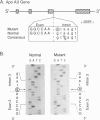Abstract
The first case of familial apolipoprotein A-II (apo A-II) deficiency was recently reported from Hiroshima, Japan, and designated apo A-IIHiroshima. The proband had no immunologically detectable apo A-II in her plasma. DNA sequence analysis showed that the proband was homozygous for a G----A transition at position 1 of intron 3 of the apo A-II gene. A sister of the proband, who had an intermediate level of plasma apo AII, was shown to be heterozygous for this base substitution. This splice-junction alteration is most likely responsible for apo A-II deficiency, since it would be expected to completely block splicing of intron 3 from the primary transcript and therefore prevent formation of functional mRNA. This deficiency seems to have little influence either on lipid and lipoprotein profiles or on the occurrence of coronary artery disease.
Full text
PDF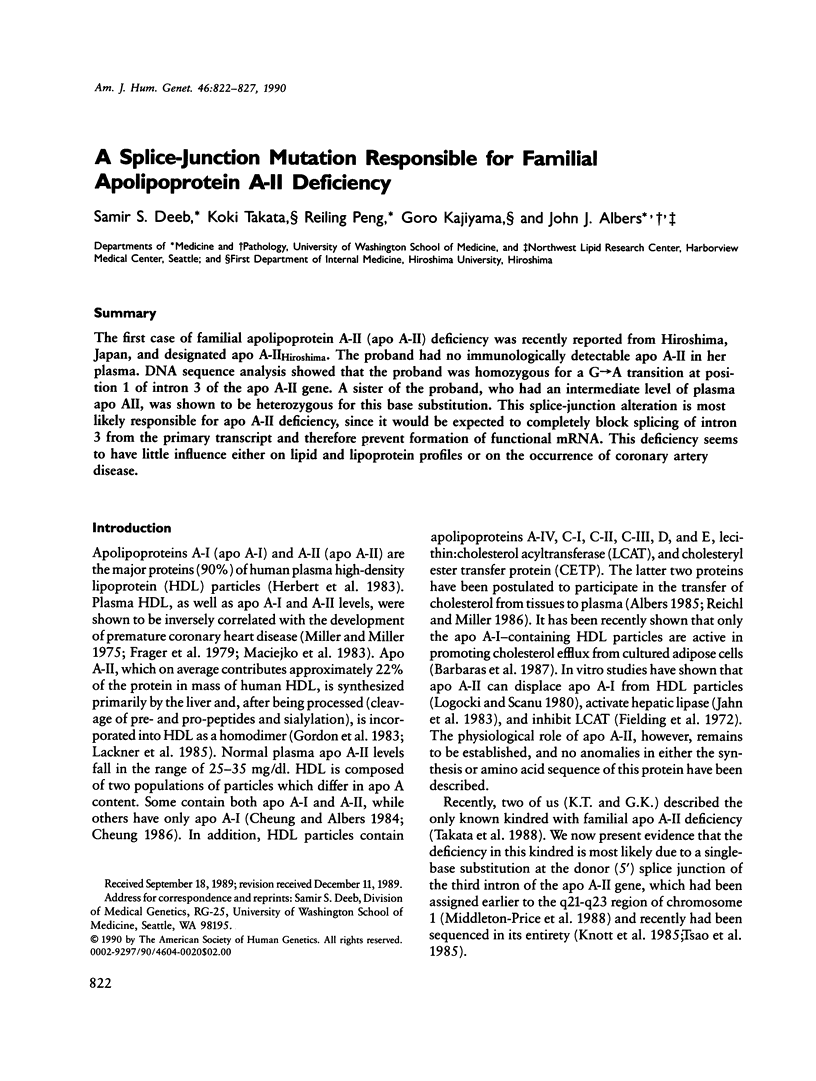
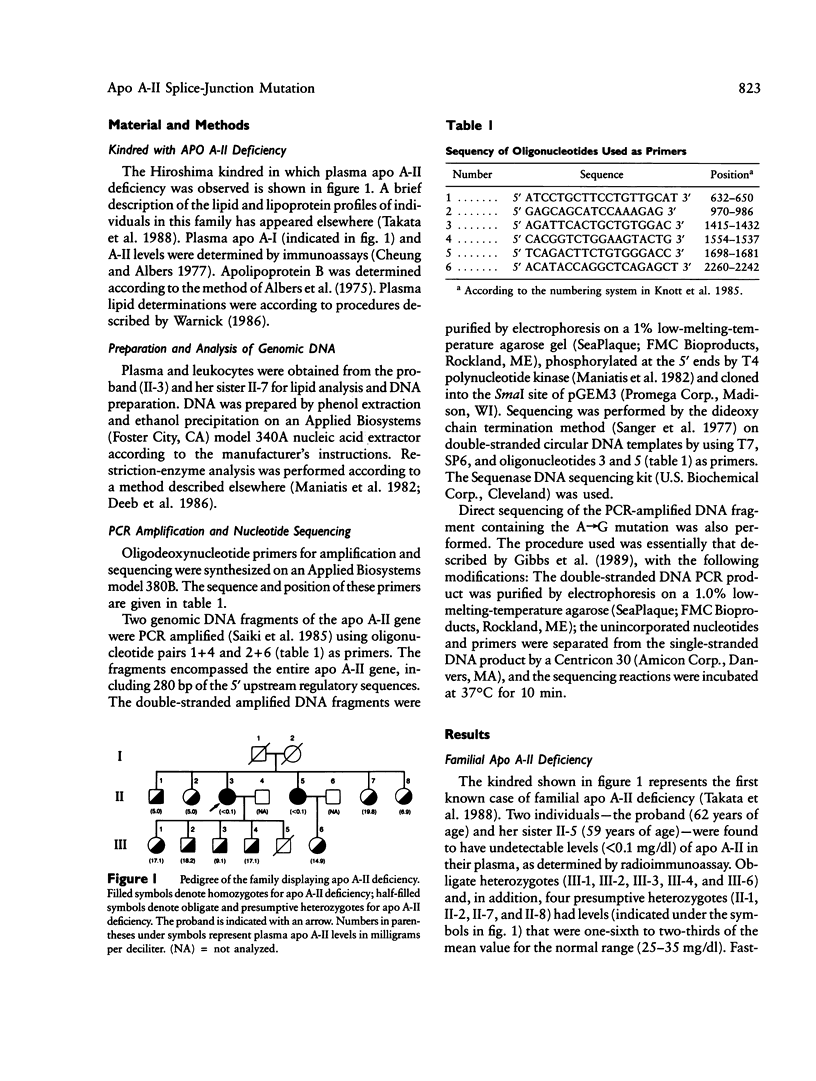
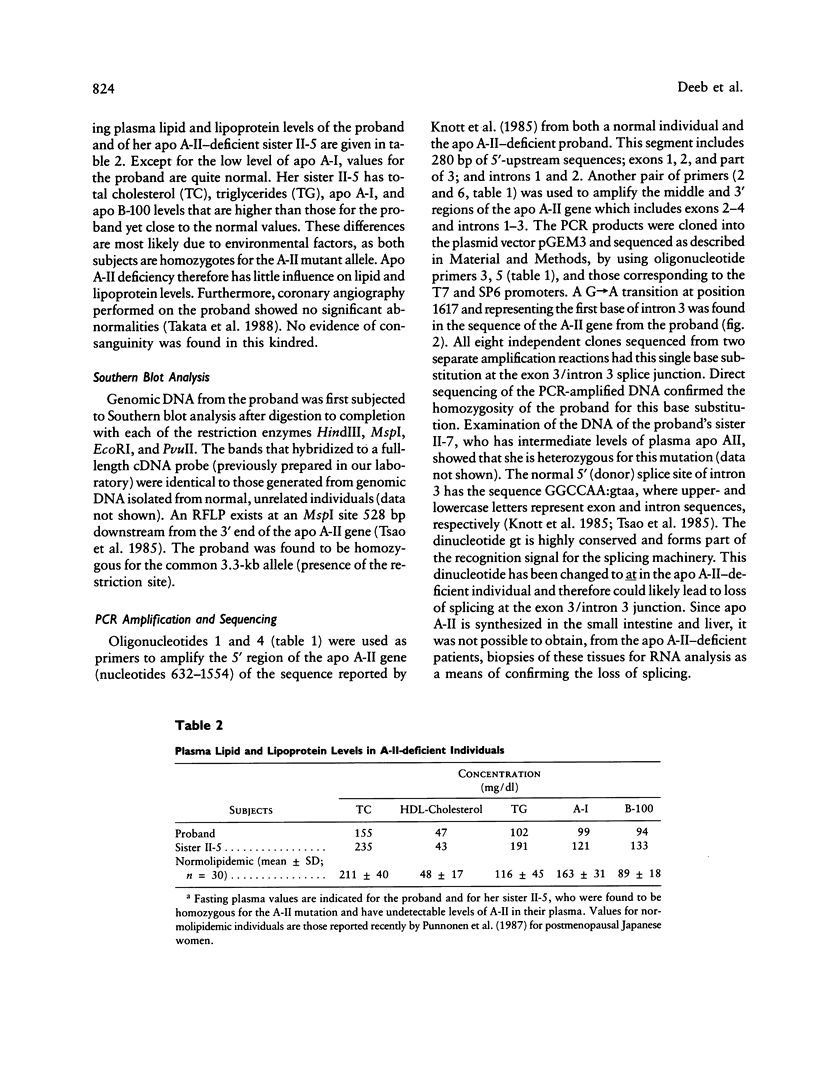
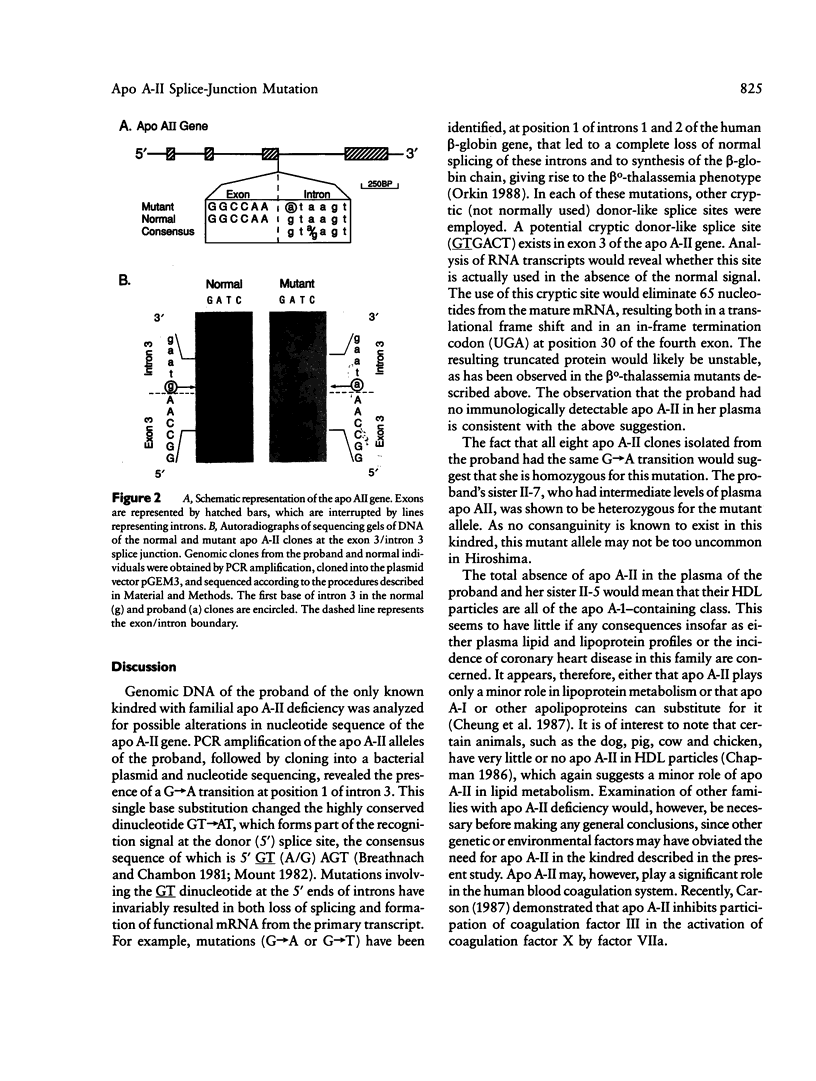
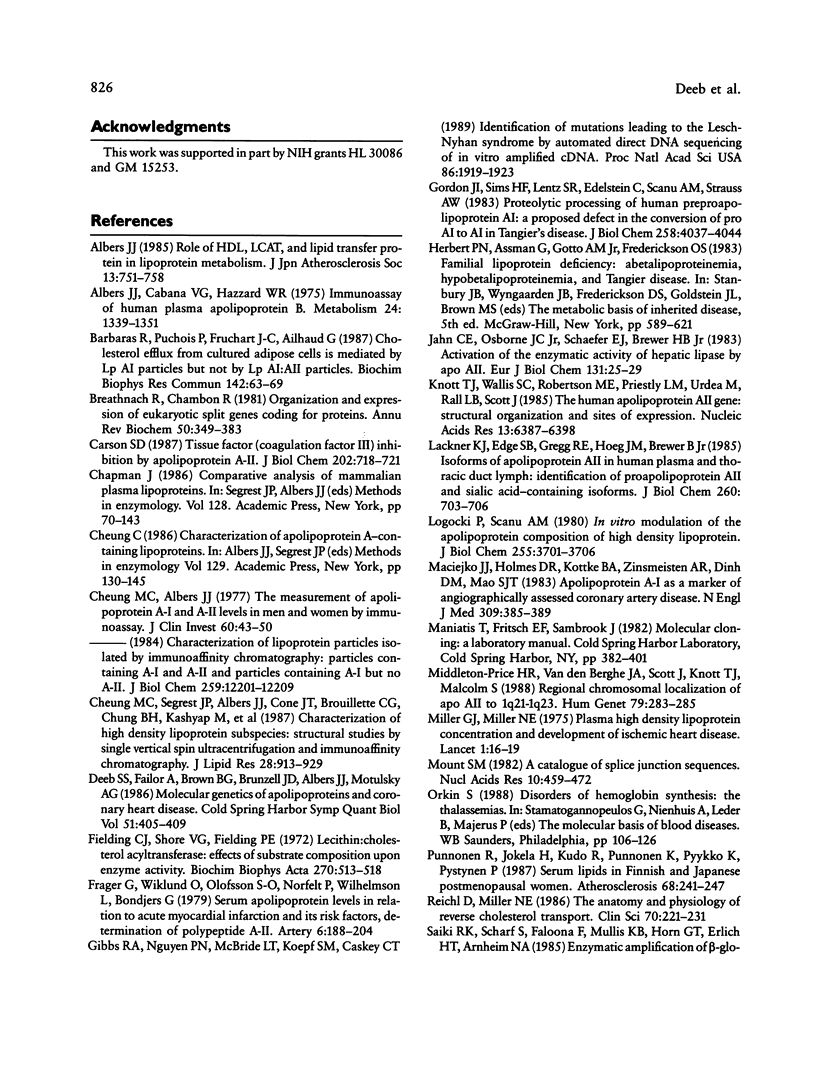

Images in this article
Selected References
These references are in PubMed. This may not be the complete list of references from this article.
- Albers J. J., Cabana V. G., Hazzard W. R. Immunoassay of human plasma apolipoprotein B. Metabolism. 1975 Dec;24(12):1339–1351. doi: 10.1016/0026-0495(75)90050-5. [DOI] [PubMed] [Google Scholar]
- Barbaras R., Puchois P., Fruchart J. C., Ailhaud G. Cholesterol efflux from cultured adipose cells is mediated by LpAI particles but not by LpAI:AII particles. Biochem Biophys Res Commun. 1987 Jan 15;142(1):63–69. doi: 10.1016/0006-291x(87)90451-7. [DOI] [PubMed] [Google Scholar]
- Breathnach R., Chambon P. Organization and expression of eucaryotic split genes coding for proteins. Annu Rev Biochem. 1981;50:349–383. doi: 10.1146/annurev.bi.50.070181.002025. [DOI] [PubMed] [Google Scholar]
- Carson S. D. Tissue factor (coagulation factor III) inhibition by apolipoprotein A-II. J Biol Chem. 1987 Jan 15;262(2):718–721. [PubMed] [Google Scholar]
- Chapman M. J. Comparative analysis of mammalian plasma lipoproteins. Methods Enzymol. 1986;128:70–143. doi: 10.1016/0076-6879(86)28063-5. [DOI] [PubMed] [Google Scholar]
- Cheung M. C., Albers J. J. The measurement of apolipoprotein A-I and A-II levels in men and women by immunoassay. J Clin Invest. 1977 Jul;60(1):43–50. doi: 10.1172/JCI108767. [DOI] [PMC free article] [PubMed] [Google Scholar]
- Cheung M. C. Characterization of apolipoprotein A-containing lipoproteins. Methods Enzymol. 1986;129:130–145. doi: 10.1016/0076-6879(86)29066-7. [DOI] [PubMed] [Google Scholar]
- Cheung M. C., Segrest J. P., Albers J. J., Cone J. T., Brouillette C. G., Chung B. H., Kashyap M., Glasscock M. A., Anantharamaiah G. M. Characterization of high density lipoprotein subspecies: structural studies by single vertical spin ultracentrifugation and immunoaffinity chromatography. J Lipid Res. 1987 Aug;28(8):913–929. [PubMed] [Google Scholar]
- Deeb S., Failor A., Brown B. G., Brunzell J. D., Albers J. J., Motulsky A. G. Molecular genetics of apolipoproteins and coronary heart disease. Cold Spring Harb Symp Quant Biol. 1986;51(Pt 1):403–409. doi: 10.1101/sqb.1986.051.01.048. [DOI] [PubMed] [Google Scholar]
- Fielding C. J., Shore V. G., Fielding P. E. Lecithin: cholesterol acyltransferase: effects of substrate composition upon enzyme activity. Biochim Biophys Acta. 1972 Aug 11;270(4):513–518. doi: 10.1016/0005-2760(72)90116-6. [DOI] [PubMed] [Google Scholar]
- Gibbs R. A., Nguyen P. N., McBride L. J., Koepf S. M., Caskey C. T. Identification of mutations leading to the Lesch-Nyhan syndrome by automated direct DNA sequencing of in vitro amplified cDNA. Proc Natl Acad Sci U S A. 1989 Mar;86(6):1919–1923. doi: 10.1073/pnas.86.6.1919. [DOI] [PMC free article] [PubMed] [Google Scholar]
- Gordon J. I., Sims H. F., Lentz S. R., Edelstein C., Scanu A. M., Strauss A. W. Proteolytic processing of human preproapolipoprotein A-I. A proposed defect in the conversion of pro A-I to A-I in Tangier's disease. J Biol Chem. 1983 Mar 25;258(6):4037–4044. [PubMed] [Google Scholar]
- Jahn C. E., Osborne J. C., Jr, Schaefer E. J., Brewer H. B., Jr Activation of the enzymic activity of hepatic lipase by apolipoprotein A-II. Characterization of a major component of high density lipoprotein as the activating plasma component in vitro. Eur J Biochem. 1983 Mar 1;131(1):25–29. doi: 10.1111/j.1432-1033.1983.tb07227.x. [DOI] [PubMed] [Google Scholar]
- Knott T. J., Wallis S. C., Robertson M. E., Priestley L. M., Urdea M., Rall L. B., Scott J. The human apolipoprotein AII gene: structural organization and sites of expression. Nucleic Acids Res. 1985 Sep 11;13(17):6387–6398. doi: 10.1093/nar/13.17.6387. [DOI] [PMC free article] [PubMed] [Google Scholar]
- Lackner K. J., Edge S. B., Gregg R. E., Hoeg J. M., Brewer H. B., Jr Isoforms of apolipoprotein A-II in human plasma and thoracic duct lymph. Identification of proapolipoprotein A-II and sialic acid-containing isoforms. J Biol Chem. 1985 Jan 25;260(2):703–706. [PubMed] [Google Scholar]
- Lagocki P. A., Scanu A. M. In vitro modulation of the apolipoprotein composition of high density lipoprotein. Displacement of apolipoprotein A-I from high density lipoprotein by apolipoprotein A-II. J Biol Chem. 1980 Apr 25;255(8):3701–3706. [PubMed] [Google Scholar]
- Maciejko J. J., Holmes D. R., Kottke B. A., Zinsmeister A. R., Dinh D. M., Mao S. J. Apolipoprotein A-I as a marker of angiographically assessed coronary-artery disease. N Engl J Med. 1983 Aug 18;309(7):385–389. doi: 10.1056/NEJM198308183090701. [DOI] [PubMed] [Google Scholar]
- Middleton-Price H. R., van den Berghe J. A., Scott J., Knott T. J., Malcolm S. Regional chromosomal localisation of APOA2 to 1q21-1q23. Hum Genet. 1988 Jul;79(3):283–285. doi: 10.1007/BF00366253. [DOI] [PubMed] [Google Scholar]
- Miller G. J., Miller N. E. Plasma-high-density-lipoprotein concentration and development of ischaemic heart-disease. Lancet. 1975 Jan 4;1(7897):16–19. doi: 10.1016/s0140-6736(75)92376-4. [DOI] [PubMed] [Google Scholar]
- Mount S. M. A catalogue of splice junction sequences. Nucleic Acids Res. 1982 Jan 22;10(2):459–472. doi: 10.1093/nar/10.2.459. [DOI] [PMC free article] [PubMed] [Google Scholar]
- Punnonen R., Jokela H., Kudo R., Punnonen K., Pyykkö K., Pystynen P. Serum lipids in Finnish and Japanese postmenopausal women. Atherosclerosis. 1987 Dec;68(3):241–247. doi: 10.1016/0021-9150(87)90203-6. [DOI] [PubMed] [Google Scholar]
- Reichl D., Miller N. E. The anatomy and physiology of reverse cholesterol transport. Clin Sci (Lond) 1986 Mar;70(3):221–231. doi: 10.1042/cs0700221. [DOI] [PubMed] [Google Scholar]
- Saiki R. K., Scharf S., Faloona F., Mullis K. B., Horn G. T., Erlich H. A., Arnheim N. Enzymatic amplification of beta-globin genomic sequences and restriction site analysis for diagnosis of sickle cell anemia. Science. 1985 Dec 20;230(4732):1350–1354. doi: 10.1126/science.2999980. [DOI] [PubMed] [Google Scholar]
- Sanger F., Nicklen S., Coulson A. R. DNA sequencing with chain-terminating inhibitors. Proc Natl Acad Sci U S A. 1977 Dec;74(12):5463–5467. doi: 10.1073/pnas.74.12.5463. [DOI] [PMC free article] [PubMed] [Google Scholar]
- Tsao Y. K., Wei C. F., Robberson D. L., Gotto A. M., Jr, Chan L. Isolation and characterization of the human apolipoprotein A-II gene. Electron microscopic analysis of RNA:DNA hybrids, nucleotide sequence, identification of a polymorphic MspI site, and general structural organization of apolipoprotein genes. J Biol Chem. 1985 Dec 5;260(28):15222–15231. [PubMed] [Google Scholar]
- Warnick G. R. Enzymatic methods for quantification of lipoprotein lipids. Methods Enzymol. 1986;129:101–123. doi: 10.1016/0076-6879(86)29064-3. [DOI] [PubMed] [Google Scholar]



